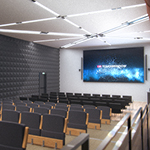
MEETING ROOM
Digital ecosystems for collaborative workspaces
We design Meeting Rooms that integrate AVC hardware, software and automation solutions to physical environments, dedicated to sharing, collaboration and comparison.
The digital life we all lead via our smartphones has accustomed us to extremely high quality standards. We expect rapid response times, direct interaction with content, rich, brilliant and detailed images from all screens. From this point of view, LED displays, which are today the most widespread, lend themselves to criticism.
An LED display screen is composed of several layers, which require significant thicknesses. The outermost layer draws the image through pixels arranged in a combination of three colors, red, green and blue (RGB). There is also a glass with support function, polarizing filters and a rear panel of LED lights, which fundamentally gives brightness.
The latter is one of the major limits of this technology, because the LED lights can be attenuated, but never completely shut down, thus constantly consuming energy. Where the image should be completely dark, it always maintains a slight brightness. Manufacturers have managed to partially reduce the problem, but never completely solve it. In addition, the LED screen progressively loses image quality as the viewing angle narrows. Even at 20°, the contrast decreases by about 50%. To overcome these limitations the OLED was born, which has many advantages and some problems.
Organic Light Emitting Diode technology (OLED) was created experimentally at the end of the 1980s, but it wasn’t until almost two decades later that it was produced and marketed on a large scale. Unlike LEDs, the OLED does not need backlighting, because the organic material (diode) present between two layers emits its own light when stimulated.
Reduction of the layers means that an OLED screen can be as slim as 4 mm, thus allowing applications on thin films. The result is screens with a minimum footprint, even foldable, applicable to curved and irregular surfaces.
The absence of a perpetually lit backlight panel greatly limits energy consumption, making the OLED display the best candidate for all battery-powered devices, such as smartphones, tablets, and portable gaming consoles.
Low consumption and a small footprint have contributed to an increasingly extensive demand for OLED technology, for example in dashboards for the car industry, in Digital Signage, and in multimedia totems. It is not difficult to imagine a future in which small high-performance OLED screens will be incorporated into household appliances, vending machines, restaurant tables... And with the advantage of acquiring information on their use which can offer increasingly personalized services.
Each pixel of an OLED display is formed by three sources placed side by side or superimposed, which provides very high resolutions up to 16 times the standard resolution of FullHD. Carbon-based electroluminescent polymers can be turned on or off, offering images with full and deep blacks. Furthermore, there is no loss of quality with a viewing angle up to 4 times greater than that of an LED screen.
The OLED display has a much faster response time than the LED. It is up to a thousand times higher, which minimizes the trail effect. This peculiarity proves to be relevant for highly defined, fast-moving images, just like in video games, for example.
The performance superiority of an OLED display compared to the LED seems evident. However, there are some critical issues that have not yet been resolved definitively. First of all, the high cost. Only a massive diffusion of OLED screens will allow a substantial price decline in the medium term, until then the LED will remain a reference point on the market, especially in the mass market.
Another weak point is the duration: as we’ve already mentioned, OLED displays use organic material, and are therefore subjected to more rapid wear than LED technology. However, the main manufacturers have already partially solved the problem and are actively working in research and development to implement increasingly long-lived OLED systems. Even the management of still images can be problematic, as these can generate an annoying latency of the image on the screen. Research seems to be well underway in this aspect too. Finally, in the presence of direct light or diffuse intense light, the LED offers greater brightness than the OLED, guaranteeing rich and brilliant images.
At present, we’re not sure if the OLED display will be the greatest revolution in digital devices or if it will end up with all the other short-lived innovations in the attic, such as 3D. At the moment, it offers excellent performance even in the touch field, as highlighted by the growing popularity of OLED displays for high-end smartphones. The versatility of very thin, low consumption and highly flexible screens testify to the assertion of this standard in the near future, but technological innovation has accustomed us to the revolutions...

We design Meeting Rooms that integrate AVC hardware, software and automation solutions to physical environments, dedicated to sharing, collaboration and comparison.

Capture audience attention and engage viewers with impactful visualization systems and integrated AVL architectures.

Trade shows, events, seminars, conventions, and art galleries become overwhelming experiences.

Alexide, the leading company in the software solutions for the digital transformation, has choosen Touchwindow to create, in its headquarter, a training room and a meeting room: two technologically advanced Digital Workspaces.

Dorelan has chosen Touchwindow to digitize the Auditorium and Meeting Rooms.

Touchwindow creates a turnkey installation at the DAMA Technopole in Bologna, featuring audio-video solutions, automation, and reconfigurable spaces.